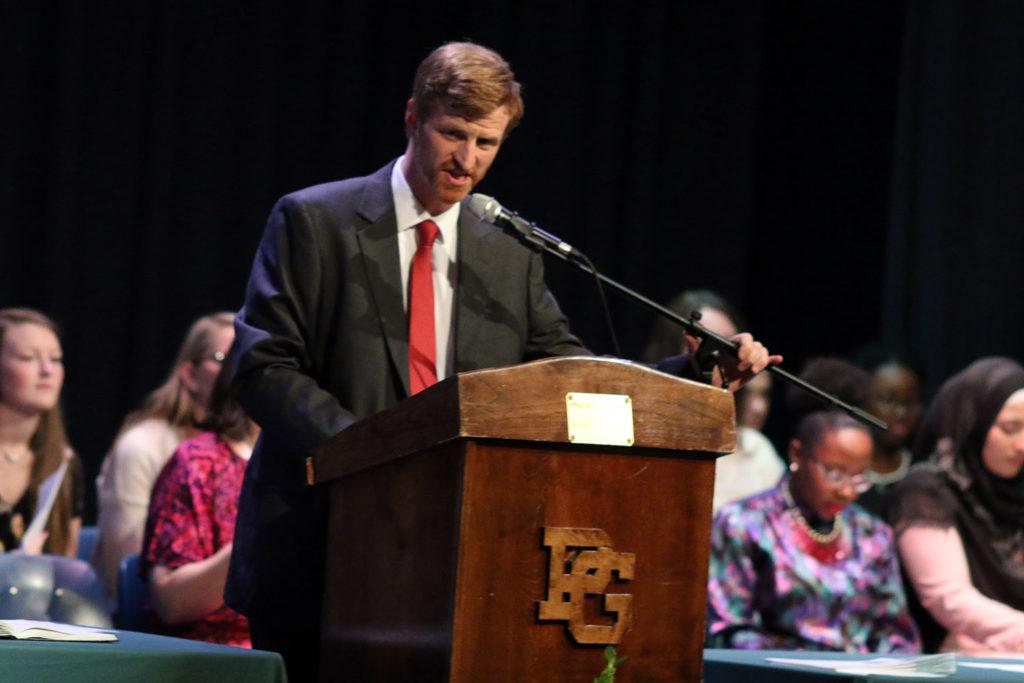After summer break ended and teachers, like history teacher Sabine Labossiere, returned to their classrooms, they were greeted with a new style of desk.
Over the summer both the high school and the junior high received shipments of these new desks. They were bought in order to replace decades old desks.
“[The decision to purchase desks] was in a discussion with Mr. Nelson and Mr. Rhodes, and I think it was last year in the spring,” Director of Secondary Education William Barnes said.
Members of administration conducted research on the effect of mobility in a learning environment. Members, including Assistant Superintendent of Instruction & Accountability Dr. Lisa Pennycuff, found that increased mobility is beneficial for the learning environment.
“The desks that we had were 30 plus years old,” Dr. Pennycuff said. “The intent was to purchase replacement furniture that would support the five C’s of the profile of Virginia Graduate. The five C’s are collaboration, communication, critical thinking, creativity, and citizenship. The desks that were selected offered the opportunity for students to work in collaborative pairs or groups, as well as the flexibility to separate the desks for independent work.”
Approximately 900 desks were purchased and put into core classrooms. They started by replacing the desks in the core classes and still intend to find more ways to improve the learning environment for the students.
Labossiere has mixed emotions on the desks, due to the discomfort she sees in her students, but also recognizes the mobility that these desks can offer.
“I mean they are easier for kids to maneuver around the room if they are permitted to work together,” Labossiere said. “However, I find that the kids have a hard time because of the little cubby, so their feet feel squished and they don’t have enough room to cross their legs.”
“Being able to move around affords the opportunity for you guys to work together, to collaborate together, more in the classroom,” Barnes said.
In addition to mobility, the old desks and chairs were constantly being broken, and after 30 years, administration thought it was time for improvement.
“One of the problems was that last year all of the desks were pretty old, and we still have some of them,” Principal Mike Nelson said. “The feeling was that it was time to get new desks, because nothing is going to last forever.”
But dealing with these desks everyday has led people to witness the shortcomings of the new desks.
“…the desks have been the topic of a few conversations. My tall students dislike them, especially,” English teacher Aline Geyres said.
These desks have raised issues for some students whose body types don’t quite fit to these desks, especially those with longer legs.
However, Nelson is working with Director of Operations Ron Rhodes to find some desks that are better suited to the body types of high school students and that still allow mobility.
“…one of the positives is that we are in the process of getting some larger desks that are going to come in,” Nelson said.
The administrators recognize the issues that these desks bring, but also identify the benefits that could come from the use of these new seats. The intent is to improve the environment with these new desks and start improving the school by replacing the old and broken furniture in the school.
“…the bodies of children and of high school students grow at much different rates…,” Dr. Pennycuff said. “So we want to be sure that we provide flexible alternative seating to fit everybody.”
Another end goal is to have furniture that is electronics-friendly. Getting the desks first help with budgeting, ordering the new equipment in steps to ensure everything is fitting perfectly in with the school’s needs.
“Ultimately we hope to have technology built devices in the high school. So what we wanted to do was have more flexible furniture that could support that and it can get expensive to try to get furniture and devices all at the same time. So we try to plan and do things in parts,” Dr. Pennycuff said.
The flexible furniture also allows greater collaboration arrangements. The idea is that the easier it is for students to work together the better the students remember the information given to them.
“It has to do with student engagement and collaboration. And if children or students…are provided opportunities to engage in conversations, to do research together, to do team projects then it [the desks] seems to have a higher ability to retain the students attention and engagement,” Dr. Pennycuff said.
The school board is still looking for the perfect fit however and is trying several different desk styles and designs. The class needs and teaching techniques are taken into account when choosing desks to try.
“It depends on the CTE issue courses with the technology because they’re already set up. We have to have desks that work in those classrooms, and, of course, our lab type classes. But it [the desks] depends on what they [the classrooms] need and what they want,” Barnes said.
Some schools even have multiple desks they are trying out at the same time trying to see what works best. The hope is to find different kinds of desks that work for the classroom as well as the students as individuals.
“Some of the other schools… have been looking at alternatives [to] seating for student engagement, and for station teaching. Some of them have some standing desks in their rooms and those aren’t the children’s actual stay at desk all day. So if a student is feeling restless they can get up and go take their work, stand at the desk, do the work there, but they still have their regular seat,” Dr. Pennycuff said.































